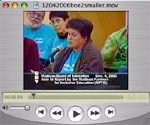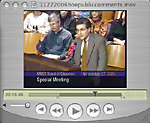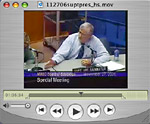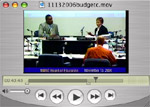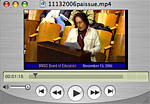The prime motivator for taking MMSD’s high schools from an academically rich curriculum to the one-room schoolhouse model has been to close the minority achievement gap. Thus, I read with interest the following NYTimes letters:
A Racial Gap, or an Income Gap? (7 Letters)
Published: November 24, 2006
To the Editor:
In emphasizing race-based achievement gaps, “Schools Slow in Closing Gaps Between Races” (front page, Nov. 20) pays insufficient attention to the significant role of socioeconomic inequalities in explaining these gaps.
For social scientists studying the No Child Left Behind law, the slow progress comes as no surprise. The education researcher David Berliner has noted that “poverty is the 600-pound guerilla in the classroom.”
As long as proponents of No Child Left Behind continue to dismiss the examination of the economic backgrounds of students as an example of what President Bush has called the “soft bigotry of low expectations” or as an excuse for low achievement by low-income students, standards-based reforms like No Child Left Behind will have limited effects.
It is time for policy makers to place as much emphasis on reducing poverty as they do on improving the schools attended by poor children. Both are necessary, but are alone insufficient to reduce the achievement gap.
Alan R. Sadovnik
New York, Nov. 20, 2006
The writer is a professor of education, sociology and public affairs at Rutgers University in Newark.
•
To the Editor:
Yes, the achievement gaps remain persistent. But perplexing? Come on.
Having 10 years’ experience teaching in low-income, largely black districts, and also having raised three middle-class white children, I consider it a no-brainer why my children achieve well in school while many of my students do not: I am one mother to three kids, but a teacher to 25.
Aside from the socioeconomic differences between my kids and my students (a separate, undoubtedly more important perspective on achievement disparities), my children get more of my attention, period.
I want to give all of my students the same advantages I’ve given my own kids, but how can I possibly meet 25 individual needs with as much sensitivity and precision?
Why does this discussion always ignore class size as a contributing factor?
Why not lower the teacher-student ratio to 1 to 10 for a few years and then study the outcomes? The obvious answer is cost. But perhaps over the years this would be offset by the savings built from a better-educated and more productive group of graduates.
Mary Scheffler
Ocean, N.J., Nov. 20, 2006
•
To the Editor:
No Child Left Behind, signed into law by President Bush in January 2002, has not closed the achievement gap between minority and white students, but it has had a major effect on education in America.
The law has had a major impact on the privatization of education. With financing now available from school vouchers, increasing numbers of both minority and white families are placing their children in private and religious schools.
In addition, American schools are increasingly becoming racially segregated as white parents remove their children from public education.
Martin Gittelman
New York, Nov. 20, 2006
•
To the Editor:
All the tests in the world will not close the achievement gap. When politicians and business leaders stop blaming the schools and start focusing on the real reasons for the achievement gap — the economic gap, the health care gap and the racial gap — poor and minority students may have a fighting chance.
Until then, the more than $2 billion testing industry will continue to reap a bonanza as our nation falls further and further into the educational abyss.
Judy Rabinowitz
Ocean, N.J., Nov. 20, 2006
•
To the Editor:
How can you discuss the test-score gaps between minority and white students without attributing some of the problem to the child poverty rate of almost 18 percent, the child hunger rate of 17 percent and the 19 percent uninsured rate for poor children, when African-Americans and Hispanics bear the brunt of those disadvantages?
Yet the education experts quoted in your article speak as if poverty and hunger, and the illnesses associated with them, had no effect on children’s school attendance and capacity to learn.
That’s not the way the principal of a school that narrowed the gap between black and white students saw it. You write that he “credited a prekindergarten program and a school health clinic that helped keep poor students from missing class.”
No Child Left Behind is big on testing and promises. But it does far too little to address the social and economic needs of black, Hispanic and poor white children — needs that are inextricably linked to school achievement.
Milton Schwebel
New Brunswick, N.J., Nov. 20, 2006
The writer is the emeritus dean of the Graduate School of Education, Rutgers University.
•
To the Editor:
Standardized tests may be relatively efficient to administer, but they do not provide the information educators need to understand and work to close the achievement gap. Teachers need detailed information about their students’ strengths and areas of need. All they get from a standardized test is a number.
If we want to make greater progress toward the goal of leaving no child behind, let’s shelve those standardized tests and work together to truly understand the nature of the achievement gap and the academic, social and economic factors that contribute to it.
Howard Miller
Dobbs Ferry, N.Y., Nov. 20, 2006
The writer is an associate professor of literacy education at Mercy College.
•
To the Editor:
A new approach to closing the education gaps between races is needed.
Instead of looking at the performance of unsuccessful schools, unsuccessful teachers and poorly performing minority students, why not look for the factors that underlie success?
A study of the successful Asian students who outperform whites and other minority students might yield some interesting insights that could be effectively applied to solving the problem of those “left behind.”
Lynn Garon
New York, Nov. 20, 2006

